
USS Guadalcanal (CVE-60) was a Casablanca-class escort carrier of the United States Navy, which served during and after World War II. She was the first ship to carry her name. She was the flagship of Task Group 22.3, a hunter-killer group which captured the German submarine U-505 in 1944.

USS Du Pont (DD–152) was a Wickes-class destroyer in the United States Navy during World War II, later reclassified as AG-80. She was the second ship named for Rear Admiral Samuel Francis Du Pont.

USS Frankford (DD-497), a Gleaves-class destroyer, was the only ship of the United States Navy to be named for John Frankford, who commanded the privateer Belvedere during the Quasi-War with France from 1798 to 1800.

USS Forrest (DD-461/DMS-24), was a Gleaves-class destroyer of the United States Navy.

USS Hubbard (DE-211/APD-53) was a Buckley-class destroyer escort in service with the United States Navy from 1944 to 1946. She was scrapped in 1966.

USS Robert I. Paine (DE/DER-578), a Buckley-class destroyer escort of the United States Navy, was named in honor of Marine Corps Private Robert I. Paine (1923-1942), who was killed in action during the attack on Tulagi on 7 August 1942. He was posthumously awarded the Silver Star.
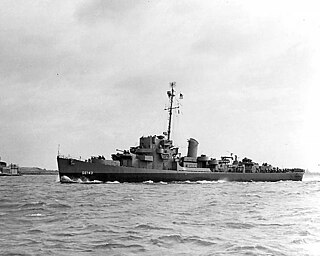
USS Fiske (DE-143) was an Edsall-class destroyer escort built for the United States Navy during World War II. Named for Rear Admiral Bradley Allen Fiske, she was the first of two U.S. Naval vessels to bear the name. The vessel entered service in 1943 and served in the Atlantic Ocean during World War II as part of a hunter-killer anti-submarine group. On 2 August 1944, Fiske was sunk by a torpedo fired by the German submarine U-804. Thirty-three of the ship's crew were killed and a further 50 were injured.

USS Huse (DE-145) was a U.S. Navy destroyer escort launched by Consolidated Steel Corp., Orange, Texas on 23 March 1943, during World War II. The ship was sponsored by Mrs. L. M. Humrichouse, daughter of Admiral Harry McLaren Pinckney Huse, whom the ship was named after and commissioned on 30 August 1943.

USS Bronstein (DE-189) was a Cannon-class destroyer escort in service with the United States Navy from 1943 to 1945. In 1952, she was sold to Uruguay, where she served as ROU Artigas (DE-2) until being decommissioned and scrapped in 1988.

USS Jacob Jones (DE-130) was an Edsall-class destroyer escort built for the U.S. Navy during World War II. She served in the Atlantic Ocean and provided destroyer escort service against submarine and air attack for Navy vessels and convoys.
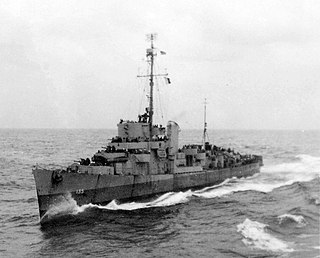
USS Flaherty (DE-135) was an Edsall-class destroyer escort in service with the United States Navy from 1943 to 1946. She was sold for scrap in 1966.
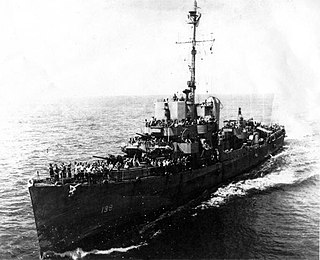
USS Farquhar (DE-139) was an Edsall-class destroyer escort in service with the U.S. Navy from 1943 to 1946. She was scrapped in 1974.

USS Fessenden (DE-142/DER-142) was an Edsall-class destroyer escort built for the U.S. Navy during World War II. She served in the Atlantic Ocean and the Pacific Ocean and provided destroyer escort protection against submarine and air attack for Navy vessels and convoys.
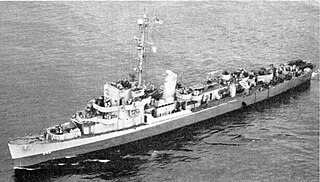
USS Sloat (DE-245) was an Edsall-class destroyer escort built for the U.S. Navy during World War II. She served in the Atlantic Ocean the Pacific Ocean and provided destroyer escort protection against submarine and air attack for Navy vessels and convoys.
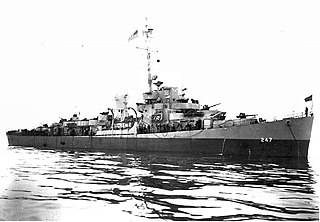
USS Stanton (DE-247) was an Edsall-class destroyer escort built for the U.S. Navy during World War II. She served in the Atlantic Ocean the Pacific Ocean and provided destroyer escort protection against submarine and air attack for Navy vessels and convoys.

USS Swasey (DE-248) was an Edsall-class destroyer escort built for the U.S. Navy during World War II. She served in the Atlantic Ocean the Pacific Ocean and provided destroyer escort protection against submarine and air attack for Navy vessels and convoys.
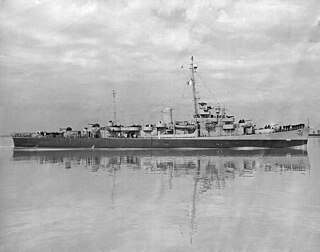
USS Mosley was an Edsall-class destroyer escort built for the U.S. Navy during World War II. She served in the Atlantic Ocean the Pacific Ocean and provided destroyer escort protection against submarine and air attack for Navy vessels and convoys.

USS Cockrill (DE-398) was an Edsall-class destroyer escort in service with the United States Navy from 1943 to 1946. After spending decades in reserve, she was sunk as a target in November 1974.

USS Neunzer (DE-150) was an Edsall-class destroyer escort in service with the United States Navy from 1943 to 1947. After spending several decades in reserve, she was sold for scrap in 1973.
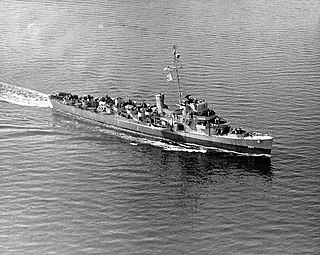
USS Jenks (DE-665) was a Buckley-class destroyer escort in service with the United States Navy from 1944 to 1946. She was scrapped in 1968.




















